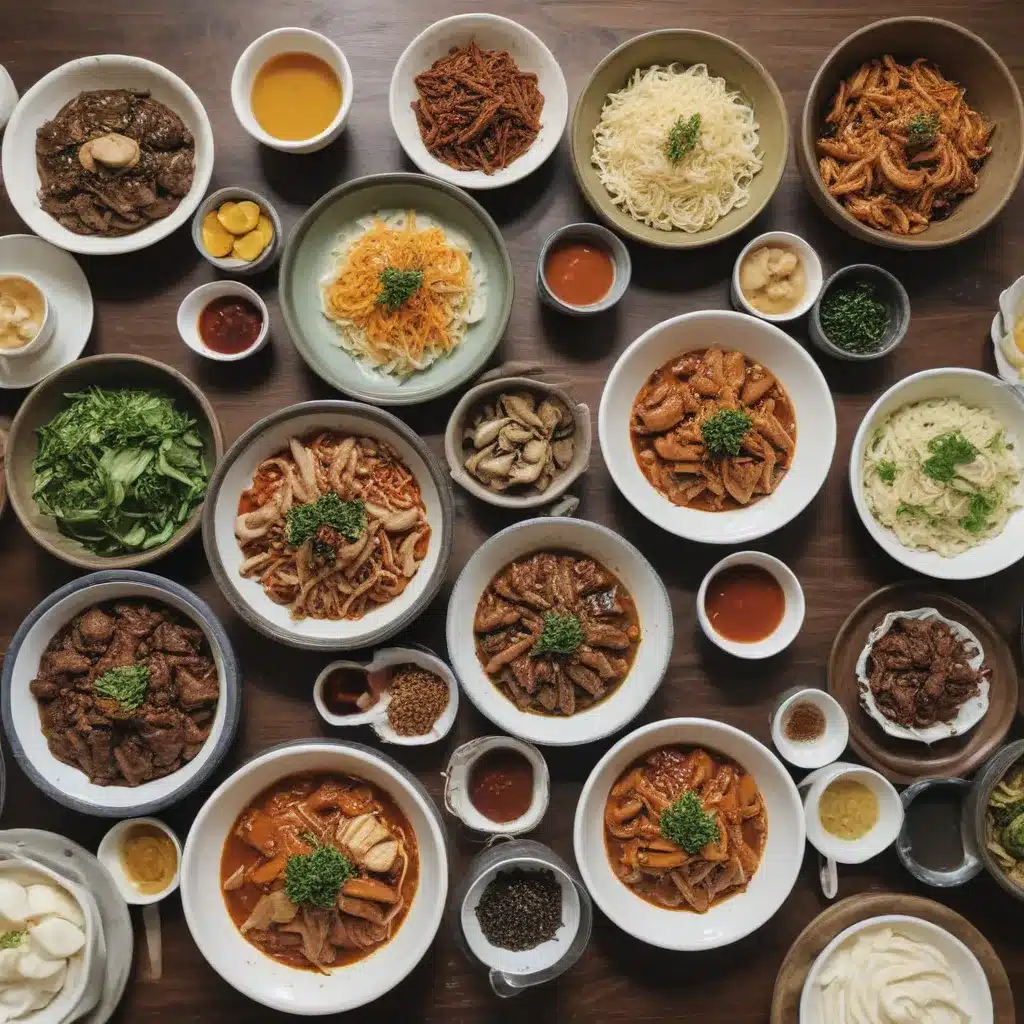
Discovering the Heart of Korean Cuisine
As I stepped out of my hotel in the vibrant heart of Seoul, the aroma of sizzling garlic and fragrant spices wafted through the air, luring me deeper into the city’s culinary maze. I had come to this bustling metropolis in search of an authentic taste of Korean home cooking, and I was determined to find it.
My first stop was a quaint neighborhood market, where ajummas (Korean middle-aged women) haggled and bartered, each one a guardian of a family’s culinary heritage. I wandered through the stalls, my senses overwhelmed by the kaleidoscope of colors and the cacophony of sounds. Ajummas waved me over, eagerly sharing the stories behind their carefully curated ingredients – from the glistening, ruby-red chili peppers to the pungent fermented sauces that had been passed down through generations.
As I learned during a local market tour and cooking class, the key to authentic Korean home cooking lies in the quality and provenance of the ingredients. These ajummas were the gatekeepers, ensuring that only the freshest, most flavorful produce made it into the family kitchens.
Mastering the Art of Banchan
With my newfound appreciation for the building blocks of Korean cuisine, I set out to explore the true heart of homestyle cooking – the banchan, or side dishes. These small plates, often numbering a dozen or more, are the foundation of a traditional Korean meal, each one a masterpiece in its own right.
I had the privilege of learning the intricate art of banchan-making from a local cooking instructor, who guided me through the delicate balance of flavors and textures that make these humble dishes so captivating. From the crisp, tangy kimchi to the silky, savory spinach, each banchan was a symphony of complementary tastes and aromas.
As I carefully layered the flavors, meticulously chopping, sautéing, and seasoning, I marveled at the time-honored techniques that had been honed over centuries. It was a humbling experience, a reminder that true mastery in the kitchen comes not from flashy techniques or exotic ingredients, but from a deep reverence for the essentials.
Discovering the Comfort of Jeon
With my banchan masterpieces complete, I turned my attention to the next chapter of my culinary journey: the art of jeon, or Korean savory pancakes. These crisp, golden discs had long piqued my curiosity, and I was eager to uncover their secrets.
Gathering a array of fresh, seasonal ingredients, I followed the instructions of my cooking mentor, carefully mixing the batter and patiently waiting for the perfect sizzle and crunch. As I bit into the first jeon, the flavors exploded on my tongue – the salty, umami-rich fillings harmonizing with the delicate, golden exterior.
I was reminded of the comforting, home-cooked meals I had savored in family-owned Korean restaurants back home, where the proprietors had poured their hearts into every dish. Here, in the bustling streets of Seoul, I found that same sense of warmth and authenticity, a connection to the rich culinary traditions that have nourished generations of Koreans.
Mastering the Art of Kimchi
No exploration of Korean home cooking would be complete without a deep dive into the world of kimchi, the fermented cabbage that is the cornerstone of the national cuisine. As I peeked into the kitchens of local households, I was struck by the reverence with which these families tended to their kimchi jars, carefully monitoring the fermentation process and adjusting the seasonings to suit their family’s preferences.
I soon learned that the art of kimchi-making is a delicate dance, requiring patience, precision, and a deep understanding of the science behind fermentation. Under the guidance of my cooking instructor, I carefully chopped, salted, and seasoned the cabbage, meticulously layering the ingredients to create the perfect balance of sweetness, heat, and umami.
As the kimchi jars sat quietly on the counter, slowly transforming, I couldn’t help but feel a sense of anticipation and reverence. This was more than just a side dish – it was a living, breathing testament to the ingenuity and resilience of the Korean people, a product of generations of culinary innovation and adaptation.
Sharing the Bounty of Homestyle Cooking
With my banchan, jeon, and kimchi masterpieces complete, I felt a deep sense of accomplishment and connection to the rich tapestry of Korean cuisine. But the true reward came when I sat down to share my creations with the local community, gathered around the table for a traditional Korean feast.
As I watched the faces of my hosts light up with delight and nostalgia, I realized that the true heart of homestyle Korean cooking lies not in the technical mastery, but in the power of food to bring people together, to forge connections, and to celebrate the traditions that have nourished a nation for centuries.
Whether you’re a seasoned Korean food enthusiast or a newcomer to the cuisine, a visit to Seoul is an opportunity to immerse yourself in the authentic, homestyle flavors that have stood the test of time. From the bustling neighborhood markets to the cozy family kitchens, the essence of Korean culinary culture is waiting to be discovered, one bite at a time.

